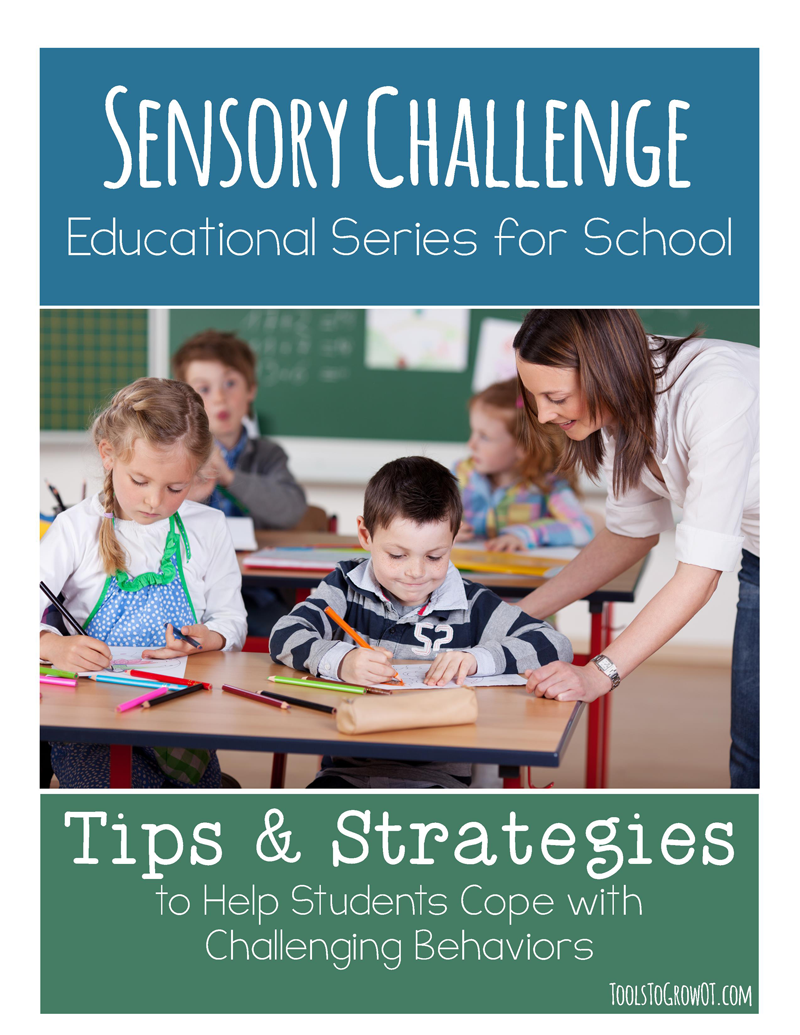Strategies to Help Students cope with Sensory Challenges
01.18.2015
Is the student in your life presenting with challenging behavior and or delays in functional skills? Are these difficulties compromising the student’s ability to learn, cooperate with daily routines, get along with others, and/or function at school, day care, or in the community? Is the child experiencing deficits in sensory processing? Are you looking for easy to read handouts that you can provide to the teachers in the child’s life that will improve your ability to consult and offer strategies? If so, we have the answer! Tools to Grow is pleased to offer our Sensory Challenge Educational Series for School.

Who are These Handouts For?
These hand outs are designed to be used by:
1. The Occupational Therapist while consulting with the teachers in the child’s life. Each hand out targets a particular sensory or sensory based behavioral challenge, or
2. Teachers and other caregivers while consulting with an Occupational Therapist or other professional who has explained and is monitoring the use of these strategies.
Layout of Handouts:
Each handout is divided into two sections based upon what the adult is observing:
1. Does Your Student?
- This section will help teachers or other caregivers pin point the common characteristics of specific sensory challenges.
- Offers educational information about the characteristics of children with the specified sensory challenge(s).
- Note that your student may present with one or many of the characteristics listed in this section. The consulting professional will assist the teacher in understanding the child’s profile.
2. Try This!
- This section offers a variety of environmental modifications, suggestions for how to respond to certain behavior, as well as strategies to teach the child to use to regulate their own behavior.
- This section offers a variety of simple suggestions and strategies to help your student develop functional skills and cooperate.
- Not all are appropriate for every student or school setting. Only use those strategies that apply to your situation. Consider the student’s age, developmental level, and situation.
The 31 page Tools to Grow Sensory Challenge Educational Series for School is comprised of four sections and eleven sub-sections. The series covers a wide range of sensory challenges and provides highly effective management strategies for each.
Section 1: Tactile
1. Over-Reacts to Touch
2. Under-Reacts to Touch
Section 2: Auditory
1. Over-Reacts to Sounds
2. Under-Reacts to Sounds
Section 3: Vestibular
1. Over-Reacts or Avoids Movement
2. Seeks Excessive Movement
3. Difficulty Sitting Still
Section 4: Attention & Challenging Behavior
1. Calming a Restless or Over-Aroused Student
2. Poor Focus/Inattention
3. Poor Ability to Play with Toys
4. Poor Transitioning Between Tasks/Activities
You can find our Sensory Challenge Educational Series for School here. We are excited to share with you a FREE handout from our Educational Series that is a common concern for classroom teachers - Difficulty Sitting Still.
Sensory Challenge: Vestibular - Difficulty Sitting Still
Does Your Student?
- When expected to sit still, he/she may constantly wiggle, slump, squirm, lean on furniture, and/or fall out of their chair.
- He/she may sit on the edge of their seat.
- He/she may look weak.
- He/she may hold his head up using his hands.
- He/she may stand more than sit.

Try This!
Modify & Examine Your Student’s Desk & Chair
- One size does not fit all- your student may need a foot rest for proper support or may need their desk legs adjusted. This is a very common problem; many children cannot adjust to a chair and desk/table that does not fit their body.
- Slice an X pattern through two tennis balls. Place one on the front leg of child’s chair and the other ball on the rear leg on the opposite side of the chair. This will allow your student to rock while remaining seated.
- Partially inflate an inexpensive plastic beach ball. Place it on the seat of his/her chair. This will allow your child to move and shift position while remaining seated. Commercially produced chair cushions that provide movement while sitting in a standard chair are available. See the school Occupational Therapist.
- Make a Hug-Chair. Place a large long sleeve shirt over the back of child’s chair. Stuff the arms with dry beans and tie tightly at the bottom of the sleeve. The student can wrap himself with the arms when he needs extra sensory input. This may help him/her stay seated.
- Use a small wedge on the seat of the chair. This helps improve the posture of a child who rounds the small of their back. The highest part of the wedge should be at the back of the seat.
- Rather than use a standard chair, if safe to do so allow child to sit on a large ball while at a table. There are commercially available ball chairs and balls with bases that are more stable. See the school Physical or Occupational Therapist.
- “Tummy-touch-the table.” Be sure your student has physical contact with the table on his belly and his feet are flat on the ground.
- Consider allowing your student to turn their chair around! He/she would then have their legs straddling the back of the chair and leaning their torso against the back of the chair. Although unorthodox for most schools, students may prefer this for short periods and re-focus.
- Secure “Theraband” around the student’s chair legs. The child may use their feet to push to kick against the tubing.
Try Chair Exercises:
- Occasional breaks for mini-exercises may boost sitting tolerance and concentration while minimizing restlessness.
- Demonstrate to your child how to use his/her own hands to push down firmly on his thighs. Repeat until student appears less restless.
- Show your child how to bring both hands to chest level. Next, push both palms together. Repeat until student appears less restless.
- Demonstrate how to place each hand on the “seat” of the chair while pushing down to perform a “chair push up.” Repeat until student appears less restless.
- Visuals and detailed explanation on chair exercises can be found here: Self-Regulation Strategies and Handwriting Warm Ups.
Other Ideas:
- Allow for movement breaks in between periods when prolonged sitting is necessary.
- Provide crunchy or chewy food or sucking liquid with a straw. This may reduce restlessness while required to sit. Be sure to consider the child’s diet, oral motor skills (chewing and swallowing), and developmental level when offering snacks.
- Allow opportunities throughout the day for movement. A child who has difficulty remaining seated needs lots of gross motor play at “non-sitting” time. Try a fun animal walk or motor planning game!
- Let the student stand- If the student will be more attentive, productive, and compliant when standing for intervals…. Give that a try! You certainly can learn while standing.
- Offer hand fidgets- Be sure the fidget does not have excessive sensory features. If so the student may over focus on the fidget rather than the classroom lesson/task.
- Weighted materials- Lap pads and shoulder wraps can help regulate a restless student. See the school Occupational Therapist.
- Provide opportunities for heavy work such as pushing desks, moving chairs, carrying heavy boxes, etc.
- Preferential seating-Seat the student away from the door, windows, or distracting classmates.
- During quiet, solitary work offer noise reducing headphones to block out distracting sounds.
- Get out of the chair-children can learn and be productive while standing, kneeling, cross legged sitting on the floor, or on their bellies.
To access our entire Sensory Challenge Educational Series click here. You can also print this FREE handout from our Educational Series on tips and strategies for a child who has difficulty sitting still.
Are you looking for more sensory regulation strategies? Read our Sensory Star Program here. The sensory star program aligns with our Sensory Education Series for School. This practical and effective intervention tool can be used in conjunction with these above tips to help with self-regulation.
These invaluable strategies and resources will provide you with the tools necessary to help with the most important job there is … helping students grow!!
Related Topics: Free Resources , Press Releases, School Based OT, Sensory Processing/Self-Regulation, Tools to Grow at School


